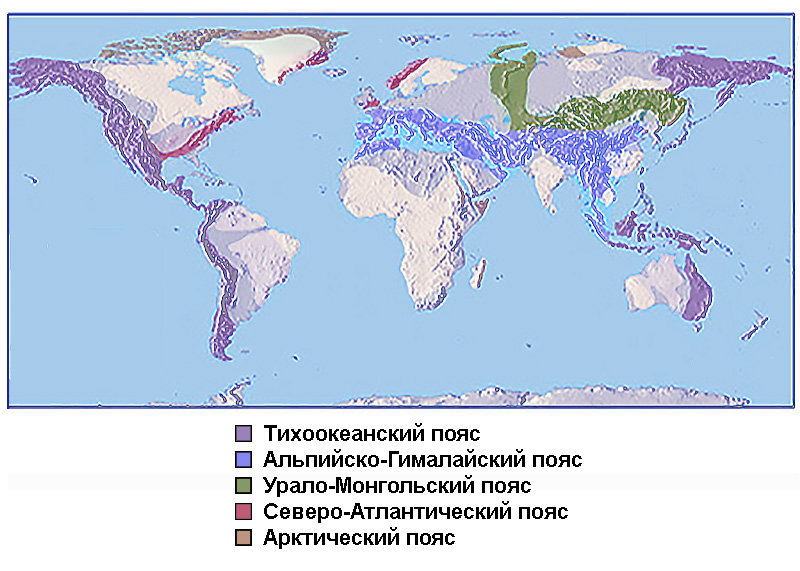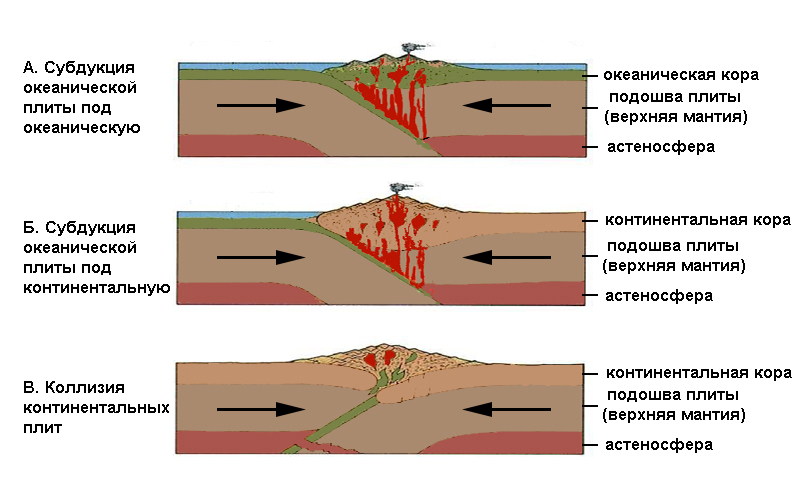The lithosphere of our planet is mobile, subject to constant changes in the scale of geological time and has a complex structure. One of the tectonic structures of global importance are folded (geosynclinal) belts. About this in this article.
The concept of a folded belt
A geosynclinal (folded or mobile) belt is a geotectonic unit characterized by magmatic, seismic, and volcanic activity. As well as large-scale metamorphic processes and a certain set of folded structures with relatively high mobility. Geosynclinal belts are distinguished by a complex of formations composing them, that is, sets of rocks that arose in similar geodynamic settings.
The length of the belts reaches tens of thousands of kilometers in length. Width is on the order of hundreds or thousands of kilometers.
In the modern sense, folded belts are associated with active continental margins and collision zones of continental plates. Belts occur at the boundaries of lithospheric plates moving towards each other (such boundaries are called convergent).
The structure of the moving belts
Belts are composed of folded (geosynclinal) regions - large formations that differ from adjacent regions in age and the features of their evolution. Regions, in turn, are formed from similar in structure or origin folded systems of close age, such as Baikalids, Caledonides, Hercynides, and others. So, the Ural Mountains are an example of the Hercynian folded system, the Himalayas are an example of an alpine system.
Geosynclinal regions and systems within the belt are separated by many different tectonic structures. These are deep faults, microcontinent, fragments of the continental and oceanic crust, magmatic intrusions, island arcs or their remains. Microcontinent are fragments of ancient Proterozoic continents and can have a significant length - up to hundreds of kilometers.
The following zones are distinguished by the nature of mountain-building processes in folded belts:
- forward (regional) deflection - the area of articulation of the platform and the folded area;
- the outer zone of the peripheral geosynclinal system, which is formed through the processes of growth and accretion of various structural elements (for example, island arcs);
- the inner zone of the orogen, which is characterized by manifestations of metamorphism and intense lateral compression due to the collision (collision) of the continental blocks.
The main moving belts of the Earth
Currently, the planet has five largest folded belts, characterized by developmental features and age:
- The Pacific belt bordering the Pacific Ocean along the edges of all continents in contact with this ocean. Sometimes, due to its gigantic extent, it is divided into the West Pacific and East Pacific (Cordillera) belts. Despite this division, reflecting some structural differences, the Pacific geosynclinal belt is characterized by the unified nature of the tectonic processes occurring in it.
- Alpine-Himalayan (Mediterranean) belt. It stretches from the Atlantic to Indonesia, where it contacts the western part of the Pacific belt. In the Tien Shan region, it practically merges with the Ural-Mongolian. The Alpine-Himalayan geosynclinal belt contains relics of the Tethys Ocean (Mediterranean, Black, Caspian Seas) and a number of microcontinent, for example Adria in Southern Europe or the Indosine Microcontinent in Southeast Asia.
- The Ural-Mongolian (Ural-Okhotsk) belt extends from Novaya Zemlya through the Ural folded system to the south and further east to Primorye, where it is articulated with the Pacific belt. With its northern part in the Barents Sea, it contacts the North Atlantic belt.
- The North Atlantic fold belt runs along the eastern edge of North America and further northwest and north Europe.
- The Arctic belt covers the continental territories along the Arctic Ocean from the Canadian Arctic archipelago through Greenland to Taimyr.

Types of geosynclinal belts
Depending on the laying conditions, two main types of folded belts are distinguished:
- Subduction (marginal-continental). The formation of the belt is associated with the process of immersion of plates bearing the oceanic crust under the edges of plates, including island arcs or active continental margins. Now there is one folded belt of this type - the Pacific. In the eastern part of the belt, the subduction process takes place with the plunge of oceanic plates under the continental margin. Moreover, powerful folded systems (Cordillera, Andes) are formed on the mainland along the edge, and there are no volcanic arcs and marginal seas in the subduction zone. The West Pacific part of the belt is characterized by other types of subduction, due to the structural features of lithospheric plates.
- Conflict (intercontinental). They are formed on the convergent boundaries of lithospheric plates as a result of rapprochement and connection of the continental massifs that make up these plates. The remaining four of the existing geosynclinal belts belong to this type. The crust during the collision process is intensively crushed with the formation of mountain ranges with a complex internal structure.

Folded Belt Evolution
Consider the development of folded structures in the subduction zone. In the general case, the processes of immersion of one plate under another lead to the buildup of the continental crust on the hanging (upper) edge of the subduction zone as a result of accretion due to peeling and crushing of the sedimentary cover from the submerging plate. Subduction zones are characterized by powerful volcanic activity. Active volcanism manifests itself throughout the Pacific belt, forming the so-called Pacific Ring of Fire, and along with accretion and other processes, takes part in mountain building.
The buildup of the continental crust and the thrust of the mainland plates lead to a reduction in the ocean. In the geological past, there were oceans that “closed” due to the convergent (oncoming) movement of the plates. Such are the famous Tethys, Iapetus, the Paleo-Asian, Boreal oceans.
If there are continental blocks in the composition of both interacting plates, when they collide, the folded belt enters a new stage of development characterized by a complex of extremely complex processes in which various tectonic structures are involved.
The collision leads to the unification of the plates, since the continental plate cannot plunge into the mantle due to the low density of most of its constituent rocks. Active tectonic processes in the geosynclinal belts gradually fade, and plates can begin a new stage in their evolution (for example, riftogenesis), often in another region.
History and Modernity of the Moving Belts of the Earth's Crust
The formation of most of the existing folded belts is associated with the "closure" of the ancient oceans and the collision of the continents. So, the Ural-Mongolian belt arose as a result of the disappearance of various parts of the Precambrian Paleo-Asian Ocean, such as the Ural, Turkestan, Mongol-Okhotsk oceans. The North Atlantic belt was formed on the site of the Iapetus ocean. With a collision of ancient continents in the supercontinent Lavrussia. The disappearance of the Boreal Ocean led to the emergence of the Arctic belt. In subsequent eras, the North Atlantic and Arctic belts were dissected by the young Atlantic Ocean.

The Pacific and Alpine-Himalayan - these are actively operating modern geosynclinal belts. In Eurasia, both manifest themselves. Kamchatka, the Kuril Islands, Sakhalin, and the Japanese islands are regions of the West Pacific mobile zone. As for the Alpine-Himalayan belt, almost all of it, with the exception of North-West Africa (Maghrib) and part of the Caribbean region, is located on the territory of the Eurasian supercontinent.
The formation of the Alpine-Himalayan fold belt covers a long period. The laying of some of its sites began in the late Proterozoic. But basically, the belt is composed of areas of Mesozoic and Alpine folding. In all parts of the belt, seismic activity and the growth of mountain structures are manifested. In addition, in the Mediterranean, where the remainder of the Tethys Ocean still exists and subduction processes are ongoing, volcanic activity is observed. Thus, the formation of the belt is in full swing and far from complete.